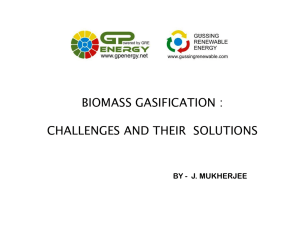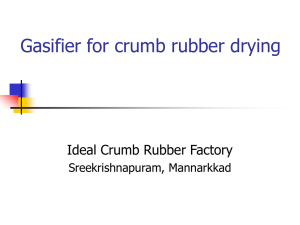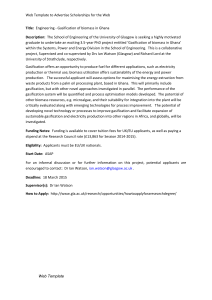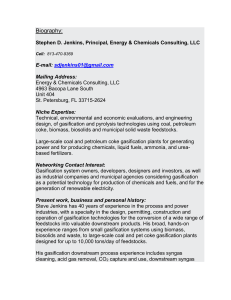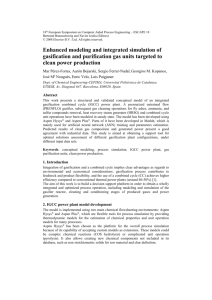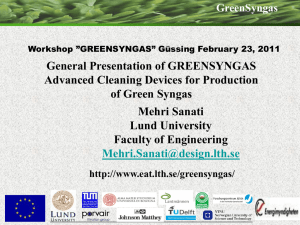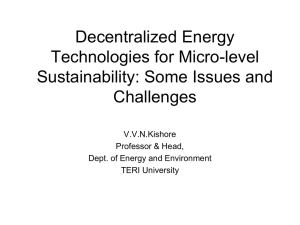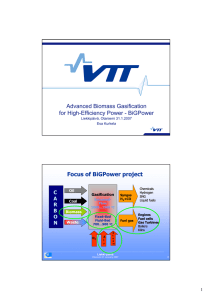49_BiomassGasificationSuccessStories
advertisement
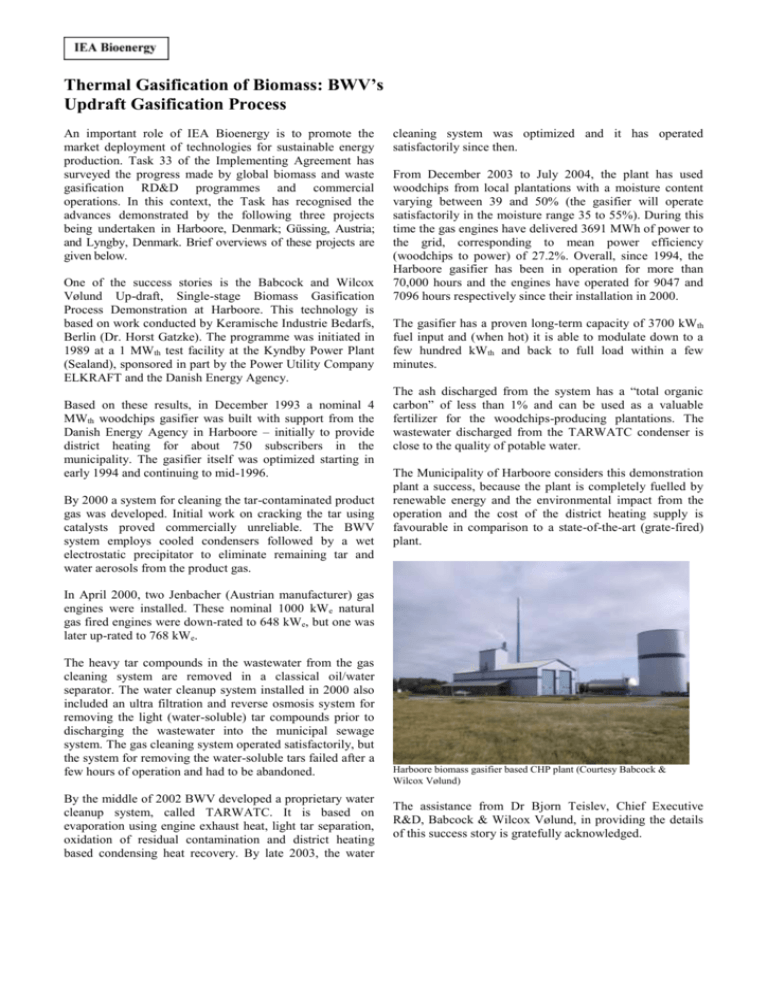
Thermal Gasification of Biomass: BWV’s Updraft Gasification Process An important role of IEA Bioenergy is to promote the market deployment of technologies for sustainable energy production. Task 33 of the Implementing Agreement has surveyed the progress made by global biomass and waste gasification RD&D programmes and commercial operations. In this context, the Task has recognised the advances demonstrated by the following three projects being undertaken in Harboore, Denmark; Güssing, Austria; and Lyngby, Denmark. Brief overviews of these projects are given below. One of the success stories is the Babcock and Wilcox Vølund Up-draft, Single-stage Biomass Gasification Process Demonstration at Harboore. This technology is based on work conducted by Keramische Industrie Bedarfs, Berlin (Dr. Horst Gatzke). The programme was initiated in 1989 at a 1 MWth test facility at the Kyndby Power Plant (Sealand), sponsored in part by the Power Utility Company ELKRAFT and the Danish Energy Agency. Based on these results, in December 1993 a nominal 4 MWth woodchips gasifier was built with support from the Danish Energy Agency in Harboore – initially to provide district heating for about 750 subscribers in the municipality. The gasifier itself was optimized starting in early 1994 and continuing to mid-1996. By 2000 a system for cleaning the tar-contaminated product gas was developed. Initial work on cracking the tar using catalysts proved commercially unreliable. The BWV system employs cooled condensers followed by a wet electrostatic precipitator to eliminate remaining tar and water aerosols from the product gas. cleaning system was optimized and it has operated satisfactorily since then. From December 2003 to July 2004, the plant has used woodchips from local plantations with a moisture content varying between 39 and 50% (the gasifier will operate satisfactorily in the moisture range 35 to 55%). During this time the gas engines have delivered 3691 MWh of power to the grid, corresponding to mean power efficiency (woodchips to power) of 27.2%. Overall, since 1994, the Harboore gasifier has been in operation for more than 70,000 hours and the engines have operated for 9047 and 7096 hours respectively since their installation in 2000. The gasifier has a proven long-term capacity of 3700 kWth fuel input and (when hot) it is able to modulate down to a few hundred kWth and back to full load within a few minutes. The ash discharged from the system has a “total organic carbon” of less than 1% and can be used as a valuable fertilizer for the woodchips-producing plantations. The wastewater discharged from the TARWATC condenser is close to the quality of potable water. The Municipality of Harboore considers this demonstration plant a success, because the plant is completely fuelled by renewable energy and the environmental impact from the operation and the cost of the district heating supply is favourable in comparison to a state-of-the-art (grate-fired) plant. In April 2000, two Jenbacher (Austrian manufacturer) gas engines were installed. These nominal 1000 kW e natural gas fired engines were down-rated to 648 kWe, but one was later up-rated to 768 kWe. The heavy tar compounds in the wastewater from the gas cleaning system are removed in a classical oil/water separator. The water cleanup system installed in 2000 also included an ultra filtration and reverse osmosis system for removing the light (water-soluble) tar compounds prior to discharging the wastewater into the municipal sewage system. The gas cleaning system operated satisfactorily, but the system for removing the water-soluble tars failed after a few hours of operation and had to be abandoned. By the middle of 2002 BWV developed a proprietary water cleanup system, called TARWATC. It is based on evaporation using engine exhaust heat, light tar separation, oxidation of residual contamination and district heating based condensing heat recovery. By late 2003, the water Harboore biomass gasifier based CHP plant (Courtesy Babcock & Wilcox Vølund) The assistance from Dr Bjorn Teislev, Chief Executive R&D, Babcock & Wilcox Vølund, in providing the details of this success story is gratefully acknowledged. Thermal Gasification of Biomass: TUV’s Steam Gasification Process Another success story is the University of Technology, Vienna, (TUV’s) Fast Internal Circulation Fluidized Bed (FICFB) biomass steam gasification process demonstration plant. In 1991 the district of Güssing in Austria adopted a new energy concept, where all energy demand would be met by renewable energy. A biodiesel plant and a district heating system, both based on biomass, were installed to achieve this. As a result 95% of the heat demand and more than 100% of the fuel demand were satisfied by renewables. Thus, in one decade, Güssing changed its energy supply to be totally based on renewables. As part of this an innovative steam gasification process, developed by TUV for combined heat and power (CHP) production was demonstrated. This latest plant is an 8 MWth CHP plant. Biomass is gasified in a duel fluidisedbed (steam blown) reactor and the resulting gas is used to produce heat and power. Some basic information on this plant is as follows: Start up of gasifier Start up of gas engine Fuel Fuel Power Electrical output Thermal output November 2001 April 2002 wood chips 8000 kW 2000 kW 4500 kW The fluidised bed gasifier consists of two zones, a gasification zone and a combustion zone. The gasification zone is a bubbling bed fluidised with steam, to make a nitrogen-free producer gas. The combustion zone is a circulating bed fluidised with air which delivers the heat for the gasification process via the circulating bed material. The producer gas is cooled and cleaned by a two stage cleaning system. A heat exchanger reduces the temperature from 850°C to about 150°. The first stage of the cleaning system is a fabric filter to remove particulates. In the second stage the gas is scrubbed to remove tar compounds. The dust from the filter, the spent scrubber liquid saturated with tar, and the condensate are thermally decomposed by recycling them to the combustion zone of the gasifier. The clean gas is finally fed into a gas engine to produce electricity and heat. Nm³/h of product gas will be evaluated for Fischer-Tropsch (FT) conversion to diesel fuels. At present, the FT reactor system is under construction. The set-up should be complete by the end of 2004 and first experimental results are expected in early 2005. TUV is also exploring the alternative approach to convert the synthesis gas to produce methane, as substitute natural gas. This work is being undertaken with the Paul Scherrer Institute and is financed partly under the EC-project RENEW and partly by national funds from Switzerland and Austria. A test rig for methanation was designed to perform experiments on a 2 kW scale. In the initial tests with synthesis gas, it was observed that after more than 120 hours on stream, the methanation catalyst demonstrated outstanding performance. More than 98% CO and 99% tar were converted to methane. The chemical efficiency of the methanation reaction was about 85%. TUV is also planning to conduct experiments with a high temperature fuel cell in conjunction with the Austrian Bioenergy Centre and the Department of Energy and Process Engineering, Norwegian University of Science and Technology, Trondheim. This work will focus on the removal of dust, chlorine and sulphur components from the producer gas. TUV has successfully scaled-up the fast-internal circulating fluidized bed process from a pilot plant at the University to a large-scale, commercial installation in Güssing. Furthermore, the supporting R&D by the research partners has been completed to an extent that allows the industrial partner to bring an economical and commercially viable biomass-driven CHP process to the market. From November 2001 to the end of July 2004, the gasifier has been operated for about 12,000 hours and the gasifier in combination with the gas engine for nearly 9000 hours. The main characteristics of the producer gas include a low nitrogen content and high hydrogen content (H2 to CO ratio of 1.6 – 1.8). Besides power production, the product synthesis gas can be used for many other applications. Within the EC-project, RENEW, a slip-stream of about 10 Biomass steam gasification plant at Güssing, Austria. (Courtesy R. Rauch) Assistance from Dr Reinhard Rauch, Institut fur Verfahrenstechnik, Vienna, in providing the details of this success story from Austria is gratefully acknowledged. references: Hofbauer, H. et al. 2002. Six Years Experience with the FICFB-Gasification process, 12th European Conference and Technology Exhibition on Biomass for Energy, Industry and Climate Protection, Amsterdam. Rauch, R. et al. 2004. Steam Gasification of Biomass at the CHP Guessing – Status of the Demonstration Plant, 2nd World Conference and Technology Exhibition on Biomass for Energy, Industry and Climate Protection, Rome. Further information can be found at http://www.renet.at or at http://www.ficfb.at. 2 Thermal Gasification of Biomass: DTU’s Viking Gasifier The third success story is the Technical University of Denmark (DTU’s) two-stage biomass gasification process demonstration plant, known as the Viking Gasifier, at Lyngby, Denmark. The Viking plant was commissioned in mid-2002 and as of October 2003 more than 2000 hours of operation with wood chips as fuel have been conducted. The plant is a small-scale gasifier with a nominal thermal input of 75 kW. The gasifier and engine have been operated continuously and unmanned for five test periods of approximately 450 hours each. Fuel Cooled exhaust Drying and pyrolysis 50 C 600 C 3 50,000 mg/Nm tar Partial oxidation Electricity > 1100 C Exhaust Engine 3 500 mg/Nm tar Mixing tank Gasification Roots blower 50 C Gas 750 C 90 C D.H. Condensed water D.H. Particles Air preheat Exhaust superheat The gas engine is an integrated part of the whole gasification plant. The excess heat from the exhaust gas is utilised for drying and pyrolysis of the biomass in the gasification system, and the engine directly controls the load of the gasifier. Plant Performance Data Thermal input Fuel Moisture content Gasifier efficiency Engine efficiency Electric efficiency Overall elect. eff. Tar level Dust level 68 kW Wood chips 35-45 % 93% 32% 27% 25% <1 mg/Nm3 <5 mg/Nm3 In April 2003 three independent institutes measured the tar content in the raw and cleaned gas. Only one of them was able to measure a minor content of tar in the raw gas (0.1 mg/Nm3 of naphthalene). The dust content in the gas was also negligible (< 5 mg/Nm3). 3 < 5 mg/Nm tar Ash 3 < 1 mg/Nm tar The Viking plant (see process diagram above) is based on the two-stage gasification process developed by the Technical University of Denmark. In this process the pyrolysis and gasification reactions which take place in two separate reactors are thermally integrated to decompose the tars and to improve the overall process efficiency. Based on the experience obtained during operation of the Viking gasifier it is concluded that the plant is easy to operate and control. So far, no problems with metal corrosion have been observed. The scale-up of the two-stage process to large capacity plant activities is planned to start in 2004 in co-operation with private companies. The 600°C hot pyrolysis products are partially oxidised by preheated air. This partial oxidation results in a temperature increase to around 1100°C at which most of the tar is decomposed. The raw gases are cooled in heat exchangers, delivering heat for the process and for district heating. The produced gas is cooled to 90°C and at this temperature the soot particles are removed dry in a simple bag house filter. Upon further cooling, the steam contained in the gas is condensed. The toxicity of the condensate has been tested and the material is acceptable for processing in Danish biological sewage plants. The cooled gas is fed to a gas engine coupled to a generator, producing power and district heating. Viking gasifier at DTU, Copenhagen, Denmark Assistance from Dr Benny Gøbel, Biomass Gasification Group, Technical University of Denmark, in providing the details of this success story is gratefully acknowledged. references: Brandt, P. et. al. 2000. High Tar Reduction in a Two-Stage Gasifier. Energy and Fuels; 14: 816-819. Gøbel, B. et. al. 2002. High Performance Gasification with the Two-Stage Gasifier. Proceedings of 12th European Conference and Technology Exhibition on Biomass for Energy, Industry and Climate Protection. Amsterdam, pp. 389-395. Henriksen, U. et. al. 2003. The Design, Construction and Operation of a 75 kW Two-Stage Gasifier. ECOS 2003, Copenhagen, Denmark, pp.1081-1088. Staiger, B. et. al. 2004. Investigation on Existing Gasifier- and Gas Cleaning Technologies with an Online-Tar Measuring System, 2nd. World Conference on and Technology Exhibition on Biomass for Energy, Industry and Climate Protection. Rome, OB7.3 Gøbel, B. et. al. 2004. Status – 2000 Hours of Operation with the Viking Gasifier, 2nd. World Conference on and Technology Exhibition on Biomass for Energy, Industry and Climate Protection. Rome, OE1.5 Further information can be found at http://www.bgg.mek.dtu.dk 3
